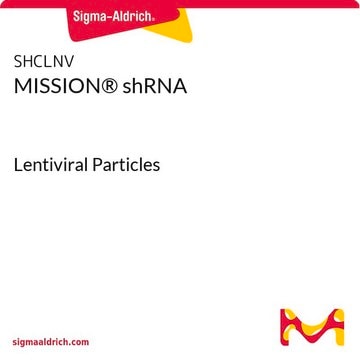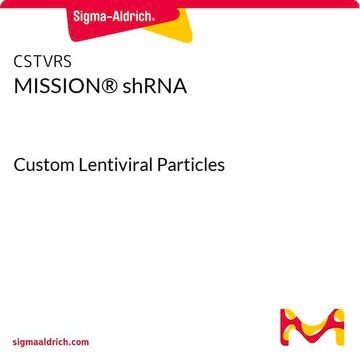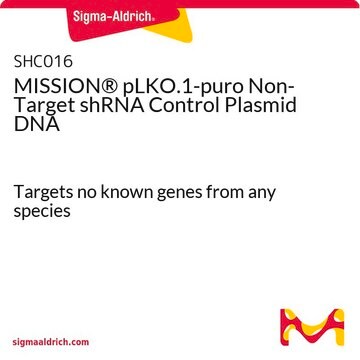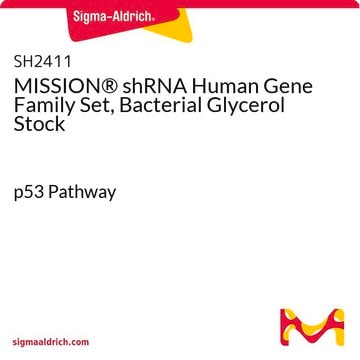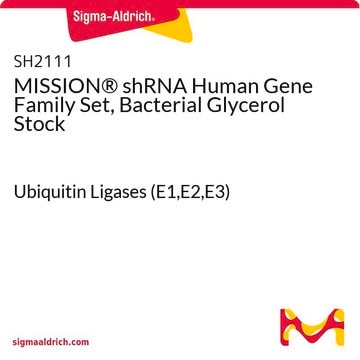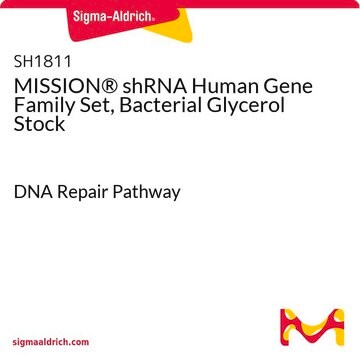Recommended Products
shipped in
dry ice
storage temp.
−70°C
Looking for similar products? Visit Product Comparison Guide
Related Categories
General description
Our comprehensive shRNA product offering consists of over 150,000 pre-cloned shRNA constructs targeting more than 15,000 human and 15,000 mouse genes. The library is available in: gene family sets: gene collections related to specific functional classes such as kinases and ion channels; gene taget sets, sets of shRNA clones that target your favorite gene; and individual shRNA clones. Our shRNA and lentiviral manufacturing platforms utilize dedicated laboratories featuring state-of-the-art robotics, liquid handling and laboratory information management systems (LIMS) to provide superior quality and service for your RNAi research needs.
MISSION® TRC shRNA bacterial glycerol stocks offer a renewable resource for shRNA plasmids. These plasmids can then be transfected directly, or packaged into lentiviral particles.
Application
MISSION® shRNA has been used in the generation of damage-regulated autophagy modulator (DRAM) and p73 knockdown cell lines. It has also been used in lentivirus generation and gene knockdown and to investigate the contribution of PAX8 (paired box 8) in ovarian cancer progression.
Other Notes
To see protocols and application data please visit sigma.com/shrna.
Legal Information
Use of this product is subject to one or more license agreements.
MISSION is a registered trademark of Merck KGaA, Darmstadt, Germany
Storage Class Code
12 - Non Combustible Liquids
WGK
WGK 2
Flash Point(F)
Not applicable
Flash Point(C)
Not applicable
Choose from one of the most recent versions:
Certificates of Analysis (COA)
Lot/Batch Number
It looks like we've run into a problem, but you can still download Certificates of Analysis from our Documents section.
If you need assistance, please contact Customer Support.
Already Own This Product?
Find documentation for the products that you have recently purchased in the Document Library.
Customers Also Viewed
Evidence of an oncogenic role of aberrant TOX activation in cutaneous T-cell lymphoma
Huang Y, et al.
Blood, 125(9), 1435-1443 (2015)
A role for PAX8 in the tumorigenic phenotype of ovarian cancer cells
Di P, et al.
BMC Cancer, 14(1), 292-292 (2014)
Nicola Currey et al.
Cellular and molecular gastroenterology and hepatology, 7(4), 819-839 (2019-03-05)
The early events by which inflammation promotes cancer are still not fully defined. The MCC gene is silenced by promoter methylation in colitis-associated and sporadic colon tumors, but its functional significance in precancerous lesions or polyps is not known. Here
Inhibition of damage-regulated autophagy modulator-1 (DRAM-1) impairs neutrophil differentiation of NB4 APL cells
Humbert M, et al.
Leukemia Research, 36(12), 1552-1556 (2012)
Namrata Bora-Singhal et al.
Scientific reports, 10(1), 4722-4722 (2020-03-15)
Non-small cell lung cancer (NSCLC) is known to have poor patient outcomes due to development of resistance to chemotherapy agents and the EGFR inhibitors, which results in recurrence of highly aggressive lung tumors. Even with recent success in immunotherapy using
Our team of scientists has experience in all areas of research including Life Science, Material Science, Chemical Synthesis, Chromatography, Analytical and many others.
Contact Technical Service
